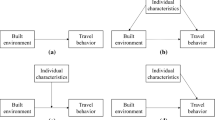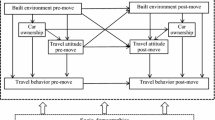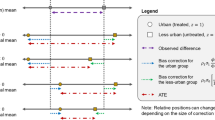Abstract
The causality issue has become one of the key questions in the debate over the relationships between the built environment and travel behavior. Although previous studies have tested statistical and/or practical significance of the built environment on travel behavior, few have quantified the relative roles of the built environment and residential self-selection in influencing travel behavior. Using 1,479 residents living in four traditional and four suburban neighborhoods in Northern California, this study explores the causal effect of neighborhood type on driving behavior and its relative contribution to the total influence of neighborhood type. Specifically, this study applied Heckman’s sample selection model to separate the effect of the built environment itself and the effect of self-selection. The results showed that, on average, the effect of neighborhood type itself on driving distance was 25.8 miles per week, which accounted for more than three quarters of the total influence of neighborhood type and 16% of individuals’ overall vehicle miles driven. These results suggest that the effect of the built environment on driving behavior outweighs that of self-selection. This paper also discussed the advantages and weaknesses of applying the Heckman’s model to address the self-selection issue.



Similar content being viewed by others
References
Babbie, E.: The Practice of Social Research, 8th edn. Wadsworth Publishing Company, Belmont, CA (1998)
Cameron, A.C., Trivedi, P.K.: Microeconomics: Methods and Applications. Cambridge University Press, New York (2005)
Cao, X., Mokhtarian P.L., Handy, S.L.: Examining the impacts of residential self-selection on travel behavior: a focus on empirical findings. Transp. Rev. (2009)
Chen, C., Gong, H., Paaswell, R.: Role of the built environment on mode choice decisions: additional evidence on the impact of density. Transportation 35(3), 285–299 (2008)
Crane, R.: The influence of urban form on travel: an interpretive review. J. Plan. Lit. 15(1), 3–23 (2000)
Ewing, R., Cervero, R.: Travel and the built environment: a synthesis. Transp. Res. Record 1780, 87–113 (2001)
Frank, L.D., Saelens, B.E., Powell, K.E., Chapman, J.E.: Stepping towards causation: do built environments or neighborhood and travel preferences explain physical activity, driving, and obesity? Soc. Sci. Med. 65, 1898–1914 (2007)
Greene, W.H.: Econometric Analysis, 3rd edn. Prentice-Hall, Inc, Upper Saddle River, NJ (1997)
Handy, S.L.: Methodologies for exploring the link between urban form and travel behavior. Transp. Res. D 1(2), 151–165 (1996)
Handy, S., Cao, X., Mokhtarian, P.L.: Correlation or causality between the built environment and travel behavior? Evidence from Northern California. Transp. Res. D 10(6), 427–444 (2005)
Heckman, J., Tobias, J.L., Vytlacil, E.: Four parameters of interest in the evaluation of social programs. South Econ. J. 68(2), 210–223 (2001)
Heckman, J., Tobias, J.L., Vytlacil, E.: Simple estimators for treatment parameters in a latent-variable framework. Rev. Econ. Stat. 85(3), 748–755 (2003)
Heckman, J.: The common structure of statistical models of truncation, sample selection, and limited dependent variables and a simple estimator of such models. Ann. Econ. Soc. Meas. 5, 475–492 (1976)
Kitamura, R., Mokhtarian, P.L., Laidet, L.: A micro-analysis of land use and travel in five neighborhoods in the San Francisco bay area. Transportation 24, 125–158 (1997)
Krizek, K.: Residential relocation and changes in urban travel: does neighborhood-scale urban form matter? J. Am. Plan. Assoc. 69(3), 265–281 (2003)
Lee, L.-F.: Generalized econometric models with selectivity. Econometrica 51(2), 507–512 (1983)
Levine, J., Inam, A.: The market for transportation-land use integration: do developers want smarter growth than regulations allow? Transportation 31(4), 409–427 (2004)
Mokhtarian, P.L., Cao, X.: Examining the impacts of residential self-selection on travel behavior: a focus on methodologies. Transp. Res. B 42(3), 204–228 (2008)
Oakes, M.J.: The (mis)estimation of neighborhood effects: causal inference for a practicable social epidemiology. Soc. Sci. Med. 58, 1929–1952 (2004)
Pinjari, A.R., Pendyala, R.M., Bhat, C.R., Waddell, P.A.: Modeling residential sorting effects to understand the impact of the built environment on commute mode choice. Transportation 34(5), 557–573 (2007)
Salon, D.: Cars and the city: an investigation of transportation and residential location choices in New York city. Ph.D. Dissertation, Agricultural and Resource Economics, University of California, Davis (2006)
Scheiner, J., Holz-Rau, C.: Travel mode choice: affected by objective or subjective determinants? Transportation 34, 487–511 (2007)
Schwanen, T., Mokhtarian, P.L.: What affects commute mode choice: neighborhood physical structure or preferences toward neighborhoods? J. Transp. Geogr 13(1), 83–99 (2005)
Singleton Jr., R.A., Straits, B.C.: Approaches to Social Research, 4th edn. Oxford University Press, New York (2005)
Sommer, B., Sommer, R.: A Practical Guide to Behavioral Research: Tools and Techniques, 4th edn. Oxford University Press, New York (1997)
Transportation Research Board and Institute of Medicine.: Does the built environment influence physical activity? Examining the evidence. Washington, DC: Special Report 282 (2005)
Vance, C., Hedel, R.: The impact of urban form on automobile travel: disentangling causation from correlation. Transportation 34(5), 575–588 (2007)
Wells, N.M., Yang, Y.: Neighborhood design and walking—A quasi-experimental longitudinal study. Am. J. Prev. Med 34(4), 313–319 (2008)
Zhou, B., Kockelman, K.: Self-selection in home choice: use of treatment effects in evaluating the relationship between the built environment and travel behavior. Transp. Res. Record 2077, 54–61 (2008)
Ziliak, S.T., McCloskey, D.N.: Size matters: the standard error of regressions in the American Economic Review. J. Socio-Econ 33(5), 527–546 (2004)
Acknowledgements
The data collection was funded by the UC Davis-Caltrans Air Quality Project, the Robert Wood Johnson Foundation, and the University of California Transportation Center. The survey was designed by Susan Handy and Patricia Mokhtarian. Thank Ed Vytlacil for his help on technical issues of sample selection models. Comments from two anonymous referees have greatly improved this paper.
Author information
Authors and Affiliations
Corresponding author
Rights and permissions
About this article
Cite this article
Cao, X. Disentangling the influence of neighborhood type and self-selection on driving behavior: an application of sample selection model. Transportation 36, 207–222 (2009). https://doi.org/10.1007/s11116-009-9189-9
Published:
Issue Date:
DOI: https://doi.org/10.1007/s11116-009-9189-9




